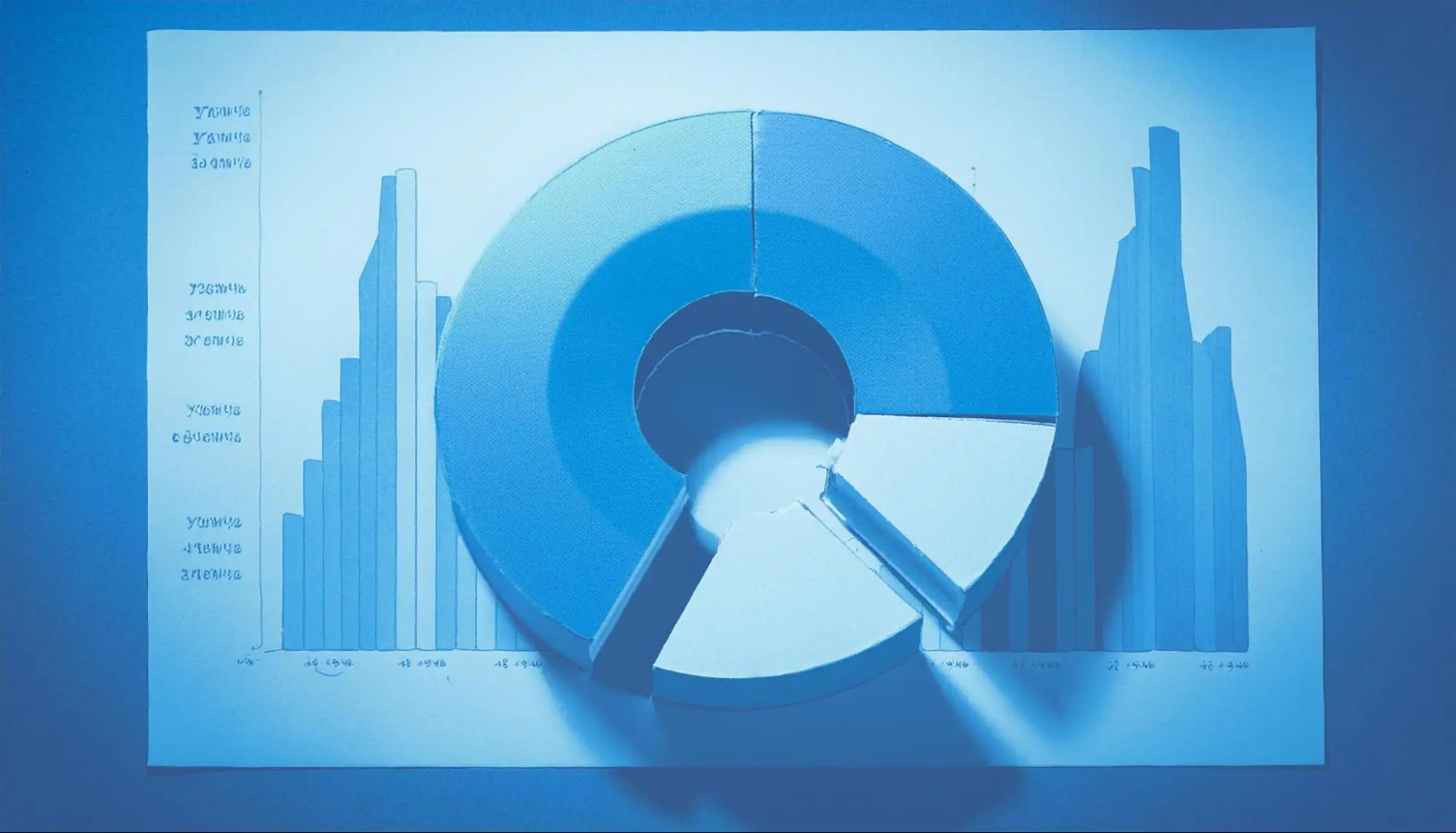Donut Chart: The Hole Story
If you’re a fan of pies then you’re going to love donuts… charts of course! If you’re hungry to learn how they work, grab a coffee and tuck in.

Everyone likes donuts, right? But does everyone like donut charts? While it’s not that sweet and puffy, it can still be extremely helpful in showcasing data in a clear and modern way.
Yeah, I know it’s not the same but hey, we don’t want to take donuts from you. We only want to give you some basic info (and also some secrets, shh…) about this type of chart so you don’t make silly mistakes and your data will be happy about the fact that such a talented person (you) utilized it so well.
What Is a Donut Chart?
A donut chart is a visualization representing data in a circular form, with each point represented by a slice. It looks like a pie chart with one essential difference: the center of the chart has been cut out to look like a donut. This modification makes the chart more aesthetically pleasing and sweet.
Examples of the best data for a donut chart include:
- Distribution of holiday gift preferences: Is it socks, gadgets, or a box of assorted donuts?
- Proportions of excuses for being late to meetings: Is “traffic” the real culprit, or just a craving for donuts?
- Composition of survey responses to “What’s your go-to comfort food?”: uncovering the love for pizza, ice cream, or a classic donut treat.
Such data is often presented using pie or donut charts. Here’s an example of utilizing a donut chart for that data.
Take a look at what people’s favorite comfort foods are. Not a pie in sight!
The following donut chart illustrates the distribution of respondents’ go-to comfort foods based on survey data. Each segment of the donut chart represents a different comfort food category, with the size of each segment corresponding to the percentage of respondents who selected that particular food.
- The largest segment represents respondents who chose donuts as their comfort food (40%).
- Pizza followers are closely behind (30%), indicating it’s a popular choice among respondents.
- Ice cream and chocolate are also favored comfort foods, with 20% and 10% of respondents selecting them.
Now a number of questions arise. First up, when can we use the donut chart to its full potential?
When Can We Use a Donut Chart To its Full Potential?
Showing Proportions
Use a donut chart when you want to display the proportional contributions of different categories to a whole, similar to a pie chart but with the center removed for additional clarity.
Highlighting Few Categories
Use donut charts when you have a small number of categories (around 2-6 is my top pick) to avoid clutter and ensure each category is easily distinguishable.
Visual Clarity
The inner hole of a donut might give you more space for labels, annotations or simply some additional information without sacrificing readability.
And here are some other great examples of when utilizing donut chart (C’mon I’m not talking about eating it) might be a great idea:
- Comparing Sub-categories (like compare sub-categories within a larger category)
- Highlighting Percentages (percentage breakdowns of a whole)
- Visualizing Progress (towards a goal, displaying completed versus remaining parts)
- Emphasizing a Key Category (make one slice stand out by simply cutting it out of the chart to highlight it)
If you cut out the next part of the article, unfortunately you won’t find out how the donut chart is built. Therefore I strongly suggest you to not skip the…
The Anatomy of a Donut Chart
It’s like donuts— the less hole there is, the happier you are because you get more of the donut itself. The hole is quite often called inner size in the world of dataviz and in various charting libraries you can control it by changing the inner size parameter.
Besides that there is also a start angle option which you should control carefully. It’s a setting that sets the start angle of the pie slices in degrees where 0 is top and 90 right.
With a donut chart, you can also display data in two levels: a general category (e.g., fruits) with subcategories (e.g., apple, lemon, etc.). It’s like adding an extra inner layer of chocolate icing.
The hole picture of categorical vs. continuous data chart types!
In the donut chart, we don’t have any axes, which makes it much simpler to use. Also the other elements of the chart are the ordinary ones so let’s skip those and move on to a list of when you definitely shouldn’t use donut charts.
When You Shouldn’t Use a Donut Chart
Yep, sometimes it sucks too. Here are a couple of examples when utilizing a donut chart might be a horrible idea.
When You Have a Lot of Categories
If you’re going to overload the chart you can also… stop doing that. If your data set is that big, why not go with a treemap, for example.
When You Need to Track the Changes Over Time
The donut chart can only show data for one specific time frame and cannot display changes over time. However, with a bit of magic it might be possible. If you’re interested, email me!
When Space is Limited
The donut chart doesn’t show a lot of information, and there are other alternatives that could convey much more information in the same space.
When You Need To Show Negative Values
For example, debt can only be represented in a financial planning donut chart as a portion of the whole and not in terms of its impact on total cash flow.
When You Want to Perform Data Analysis
Relying solely on a donut chart can be challenging because it offers a fair but relatively simple data visualization.
When Differences Between Data are Subtle
They might not be clear on the chart. A bar chart or line chart might provide clearer comparisons.
There are probably more of those but these are the most important ones. Now you know the anatomy of the donut chart, when to use it and when not to use it, it’s finally time for the donut chart recipe!
Donut Chart Best Practices
Now it’s time to create a dope donut chart on your own. It should be a piece of cake as (if you got there) you’re a donut lover. Here’s a recipe with some extra tips.
Avoid putting too many categories on the donut chart
Decide what you want to tell your readers with the chart (the message should be simple). Let’s go with a fair, and simple question – What’s your favorite sport?
One chart with all the details, and one kept simple with just 5 points.
Don’t make the inner hole too big
Just take a look.
The bigger the whole, the harder it is to read… unless that is you’re planning to add a label inside, then it changes everything!
That’s why we go with the Inner Size option set to something small like 40 percent.
Paint donut chart with a light and stylish color palette
Default colors from any charting library are… let’s be fair, not the best. Use a color generator like: https://coolors.co/ and put this beautiful palette on your data viz piece of cake… sorry, I meant art!
One chart has a mix of random colors and the other shows how a good palette can make it pop!
Add some percentage labels to the points
With a donut chart we know more or less what the proportions are, but why not show the specific values to the readers?
Basic labels are fine, but throw in percentages and suddenly everything makes more sense!
Here we go, the perfect chart is ready.
Donut Chart Overview
- A donut chart is a circular data visualization resembling a pie chart, but with the center removed to create a donut shape.
- It was made to display the proportional contributions of different categories to a whole. That’s how you should use it.
- When you should use the donut chart:
- Showing proportions: Between your categories, simply as that.
- Highlighting a few categories: Don’t go with this chart if you have more than 6 categories. Donuts were made for a small amount of data.
- Visual clarity: The inner hole of a donut gives you extra space for additional labels. Don’t waste this space.
- When you shouldn’t use the donut chart:
- When differences between data are subtle: They might not be clear on the donut chart. Use a bar chart as an alternative.
- When space is limited: Donut charts show less information. Other alternatives convey more in the same space, bar chart for example.
- When you need to track changes over time: The donut chart is fixed and cannot depict data trends across time. For showing data trends you can use a bar chart for example.
- When you need to show negative values: There’s no way to do it here but there is with a bar chart (yeah, secretly I’m a bar chart lover).
- Four tips for using donut chart:
- Avoid putting too many categories on the donut chart
- Don’t make the inner hole too big
- Add some percentage labels to the points
- Paint donut chart with a light and stylish color palette
The Bottom Line
I hope that now your data is entirely happy about you using it on a well-designed donut chart.
Remember that the donut chart works best for showing proportions between a few categories. You shouldn’t use it for deep data analysis or when you need to track changes over time. For those purposes you should definitely check the bar chart.
Don’t forget to keep the inner hole properly adjusted to the chart size, so don’t make it too big. Also keep in mind that it might be wise to add some percentage labels to the chart, to show specific differences between the points.
Thanks for reading and bon appétit!




